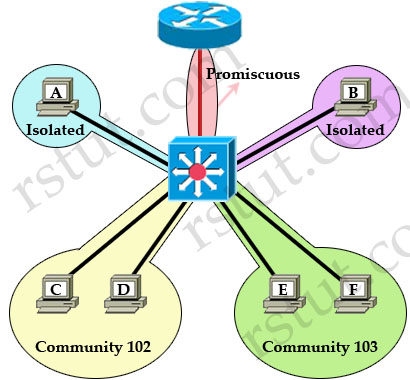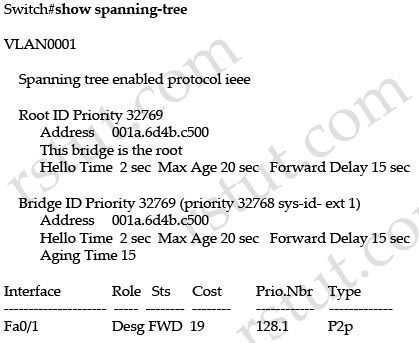Private VLAN Questions
Question 1
Which two statements about private VLANs are true? (Choose two)
A. Only one isolated VLAN can be mapped to a primary VLAN.
B. Only one community VLAN can be mapped to a primary VLAN.
C. Multiple isolated VLANs can be mapped to a primary VLAN.
D. Multiple community VLANs can be mapped to a primary VLAN.
Answer: A D
Explanation
The main purpose of Private VLAN (PVLAN) is to provide the ability to isolate hosts at Layer 2 instead of Layer 3. As you know, a VLAN is a broadcast domain, by using PVLAN we are splitting that domain into some smaller broadcast domains. For example, without PVLAN, a service provider wants to increase security by isolating customers into separate domains so that they can’t access each other, they have to assign them into different VLANs and use different subnets. This can result in a waste of IP addresses and difficulty in VLAN management. Private VLANs (PVLANs) can solve this problem by allowing the isolation of devices at Layer 2 in the same subnet. PVLAN can be considered “VLANs inside VLAN”.
There are three types of ports in PVLAN:
* Isolated: only communicate with promiscuous ports. Notice that it cannot even communicate with another isolated port. Also, there can be only 1 isolated VLAN per PVLAN.
* Promiscuous: can communicate with all other ports. The default gateway is usually connected to this port so that all devices in PVLAN can go outside.
* Community: can communicate with other members of that community and promiscuous ports but cannot communicate with other communities. There can be multiple community VLANs per PVLAN.

For example, in the topology above:
+ Host A cannot communicate with Host B, C, D, E and F. It can only communicate with Promiscuous port to the router. Notice that even two Isolated ports in the same VLAN cannot communicate with each other.
+ Host C can communicate with Host D because they are in the same community but Host C cannot communicate with E and F because they are in a different community.
+ All hosts can go outside through promiscuous port.
Also I want to mention about the concept of “primary VLAN” and “secondary VLAN”. PVLAN can have only one primary VLAN; all VLANs in a PVLAN domain share the same primary VLAN. Secondary VLANs are isolated or community VLANs.
Question 2
Refer to the exhibit.

If you change the Spanning Tree Protocol from pvst to rapid-pvst, what is the effect on the interface Fa0/1 port state?
A. It transitions to the listening state, and then the forwarding state.
B. It transitions to the learning state and then the forwarding state.
C. It transitions to the blocking state, then the learning state, and then the forwarding state.
D. It transitions to the blocking state and then the forwarding state.
Answer: C

Q2 answer D must be correct
@Hamid I agree otherwise whats the point rstp
The difference is that it skips the listening state. There is still a learning state in RSTP.
Q2 the answer is C. D could cause switching loops. @Kyle is correct. The learning state is still there
See CCIEv5 Cert Guide page 129.
They are not asking about PortFast, but about RSTP. Q2. Answer C.
Why is it transitioning into the blocking state first?
Why C? Rapid-PVST has only three states (Discarding, Learning and Forwarding). In that regards must be B
Hamid saffarzade kose nanat
Hamid safarzade kir too koonet dayus
@Anony, apparently Cisco uses Discarding and Blocking interchangeably. Most pages I see state Blocking is the port state for Rapid PVST+/802.1w
Hi all
Why is question 2 under the section for private VLANs rather than the STP section?
Are these dumps still valid ?
HI
Where do I LOGIN in and pay to get the CCIE RS V5 questions with detailed answers?
Thanks
Ado
i think, because neighbor switch still use PVST and so it canot use proposal, fa0/1 go all way of states and timers. so answer C